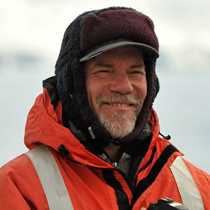Vaerøya, Reine and Trollfjord
A long straight quotation mark for Scandinavia, the Lofoten Islands stretch out into the sea from the west coast of Norway. Mostly linked together by a highway from the mainland, the islands are a popular summer escape for many of the country’s active and adventurous people. Here, above the Arctic Circle, there is no night throughout the month of June and very little in May or July. The long days can bring sunshine or storm but the soaring, fluted peaks above the colorful villages are beautiful in any weather.
The archipelago is as knotted and gnarled as a troll’s spine. Even the smallest islands rise into impressive toothy peaks above the sea. Elsewhere along the Norwegian coast the great glaciers of the ice ages have worn the remaining islands down to smooth, low mounds of rock, but the gneiss of the Lofotens is exceptionally hard and was able to resist, at last in part, the terrible force of the ice. The glaciers passed around them and ten thousand years ago their peaks stood above the ice fields as islands of rock. But as they passed, the glaciers carved the gneiss into the remarkable mountains we saw today, sweeping in elegant curves above a sparkling blue sea.
During breakfast the National Geographic Explorer anchored in the wide bay on the south side of Vaerøya, near the western end of the chain of islands. It was a bright blue-sky morning, the high cliffs around the bay crowned with brilliant emerald meadows, shining in the sun. Very soon we were fanning out from the ship. The Zodiacs brought some of us ashore at an abandoned but still well-kept fishing village, while others set out for a cruise around the western tip of the island to the bird cliffs. The calm water gave the small boats a great opportunity to explore along the base of the rocks where gulls and murres were nesting. Oystercatchers winged by, constantly wheeping as they flew, and a few colorful, comic puffins rested on the water close to our boats.
Meanwhile, the hikers set out through the village. The trail rapidly mounted the bluffs near the settlement and then continued along the cliffs, becoming the narrowest of wagon tracks, clinging to the rock more than a hundred feet above the sea. The views of the bay below were spectacular, wildflowers bloomed all along the way, and we were able to continue through a notch in the island’s wall and down to the rocky shore on the north side. We did a bit of tide-pooling there and chatted about the nesting seabirds before heading back with plenty of time to pause and soak up the sunshine or capture moments of the morning with our cameras.
The beautiful weather continued through the afternoon when we landed at the lovely little fishing village of Reine. Once again we had the choice of a Zodiac cruise or a stroll around town. This time, on the cruise around the harbor, we found elegantly built fishing vessels and many large racks of drying cod. For walkers the village offered close views of the drying fish, colorful old buildings, and a chance for a relaxing cup of coffee or a beer in the pub. Regardless of which activity we chose, it was a gorgeous afternoon in Reine’s snug multi-armed harbor, surrounded by the matchless backdrop of the towering mountain teeth.
In the evening, as the finishing touch for our long and exciting day, the National Geographic Explorer cruised into the narrow granite-walled waters of Trollfjord. With long Arctic twilight glowing around us, we all gathered on deck to cheer on the Captain’s skill in maneuvering our ship into this constricted, dead-end passage. And as our ship slowly turned at the head of the passage, a troll maiden, bearing a striking resemblance to our expedition leader, appeared on deck. As the bow swung around she leaned out and successfully plucked a branch of the sacred Rowan from the wall of the fjord, thus ensuring a happy and blessed marriage ceremony later in the year.




